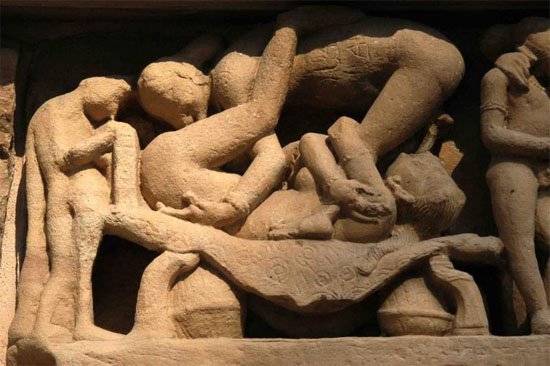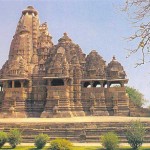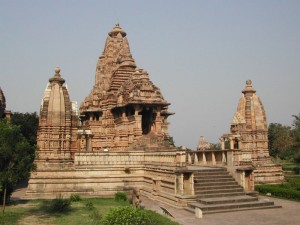 Located in the provincial state of Madhya Pradesh India. Khajuraho city is famous the world over for its temples, sex, architecture and sculpture. The construction of these Temples and sculptures are thousands of year old which took a little over two centuries, in terms of architecture of these temples, they form the high peak of the north Indian ‘nagar’ style. Starting from the Mughal invasion and the early British forays into India, Khajuraho temples in India remained unknown. Rediscovered in this century, they are fine reminders of India’s glorious past.
Located in the provincial state of Madhya Pradesh India. Khajuraho city is famous the world over for its temples, sex, architecture and sculpture. The construction of these Temples and sculptures are thousands of year old which took a little over two centuries, in terms of architecture of these temples, they form the high peak of the north Indian ‘nagar’ style. Starting from the Mughal invasion and the early British forays into India, Khajuraho temples in India remained unknown. Rediscovered in this century, they are fine reminders of India’s glorious past.
Khajuraho has still looking for the attention it deserves for its significant contribution to the religious art of India – there are literally hundreds of exquisite images on the interior and exterior walls of the shrines. The tourist activity are the temples built by the Chandela Rajputs, who can be traced as descendants of the moon god. The 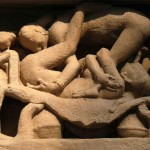 head of the clique is believed to have been a valiant warrior who fought lions bare-handed hence the emblem, frequently seen at the temples, of a warrior grappling with a lion. The flurry of temple- building which began about the middle of the 9th century and continued until the early 12th century must have used the skills of thousands of sculptors, architects and masons; unfortunately, there is almost no record of this activity in the archives of Indian history. By the time the last temple was completed the Chandela dynasty had sunk into stupor. The most important aspect of the temples in khajuraho is the abundance of sculptures.In this profusion of images attention has understandably been paid to divinities, less Understandably to celestial beauties and the female forming general and, controversially, to graphic sexual representations. Over the years a number of explanations have been approaching for the presence of erotic sculptures at what was essentially a religious centre; but no single theory, however, has been able to justify their copious expression.
head of the clique is believed to have been a valiant warrior who fought lions bare-handed hence the emblem, frequently seen at the temples, of a warrior grappling with a lion. The flurry of temple- building which began about the middle of the 9th century and continued until the early 12th century must have used the skills of thousands of sculptors, architects and masons; unfortunately, there is almost no record of this activity in the archives of Indian history. By the time the last temple was completed the Chandela dynasty had sunk into stupor. The most important aspect of the temples in khajuraho is the abundance of sculptures.In this profusion of images attention has understandably been paid to divinities, less Understandably to celestial beauties and the female forming general and, controversially, to graphic sexual representations. Over the years a number of explanations have been approaching for the presence of erotic sculptures at what was essentially a religious centre; but no single theory, however, has been able to justify their copious expression.
History of Khajuraho
Khajuraho invokes the mind, Fires the imagination. Few hundred of miles from civilization, deep in the hinterlands of central India where the tiger still has its own domain and where the depths of the forestshold their own secrets are a small clearing. a village, modest by any standards; a tank, ambitiously called a lake; groups of ancient temples, some in ruins. For most people, Khajuraho continues to remain an enigma, a quest in the arena of world art. What is the significance of its temples? What pattern did they fit into in the ancient past, and why were temples used as an art gallery? If there existed a kingdom here, where are the remains of grand mansions and grander palaces? Why is it that only temples have been discovered? Were these temples religious in nature? If so, how does one justify the presence of some of themost graphic representations of sexual scenes the world has ever known? Art historians have tried for years to seek a solution to the mystery of Khajuraho, but all attempts to do so must eventually be reduced to conjecture, for there are no records to reveal the purpose for the building of these temples. Perhaps we will never know; that is certain. However, Khajuraho will continue to draw homage from travellers and art lovers, as it has done ever since its revival.
An Ancient Past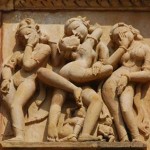 , Ancient dynasties are often covered in a veil of mystery, largely because written records are rare and, as is often the case in India, myth and legend weave their way over time into the history of their origin and their reign. And when the dynasty leaves a legacy as contradictory as the Khajuraho temples, with their mix of the religious and the sensuous, the web is woven of brighter threads, the accompanying legends more colourful. Khajuraho or ‘Khajur-vahika’ (bearer of date palms), also known as ‘Khajjurpura’ in ancient times, evidently derives its name from the golden date palms (khajur) that adorned its city gates and, if the different legendary versions are to be believed, it owes its existence to an enchanting maiden named Hemvati. According to the account of the medieval court poet, Chandbardai, in the Mahoba-khand of his Prithviraj Raso, Hemvati was the beautiful daughter of Hemraj, the royal priest of Kashi (Varanasi). One summer night, while she was bathing in the sparkling waters of a lotus-filled pond, the Moon god was so awestruck by her beauty that he descended to earth in human form and ravished her. The distressed Hemvati, who was unfortunately a child widow, threatened to curse the god for ruining her life and reputation. To make amends for his folly the Moon god promised that she would become the mother of a valiant son. ‘Take him to Khajjurpura’, he is believed to have said. ‘He will be a great king and build numerous temples surrounded by lakes and gardens. He will also perform a yagya (religious ceremony) through which your sin will be washed away.’ Following his instructions, Hemvati left her home to give birth to her son in a tiny village. The child, Chandravarman, was as lustrous as his father, brave and strong. By the time he was 16 years old he could kill tigers or lions with his bare hands. Delighted by his feats, Hemvati invoked the Moon god, who presented their son with a touchstone which could turn iron into gold, and installed him as king at Khajuraho. Chandravarman achieved a series of brilliant victories and built a mighty fortress at Kalinjar. At his mother’s request he began the building of 85 glorious temples with lakes and gardens at Khajuraho and performed the bhandya-yagya which expunged her of her guilt. A variation of the same legend introduces Hemvati as the widowed daughter of Mani Ram, the royal priest of Kalinjar. As a result of a mistake in his calculations thepriest informed his king that a particular night was Puranmasi (full moon night) and not the dark night that it actually turned out to be. In her concern for her father’s reputation the beautiful Hemvati prayed to the Moon god, who was gracious enough to uphold the word of the priest but, inreturn for his favour, ravished the daughter. The grieving father was so shame-stricken that he cursed himself and turned into a stone, which was later worshipped by the Chandelas as Maniya Dev. Hemvati gave birth to a son, the sage Chandrateya, who was later at the helm of the Chandela clan. Historically speaking, the area and aura around Khajuraho has always been renowned for its cultural achievements.
, Ancient dynasties are often covered in a veil of mystery, largely because written records are rare and, as is often the case in India, myth and legend weave their way over time into the history of their origin and their reign. And when the dynasty leaves a legacy as contradictory as the Khajuraho temples, with their mix of the religious and the sensuous, the web is woven of brighter threads, the accompanying legends more colourful. Khajuraho or ‘Khajur-vahika’ (bearer of date palms), also known as ‘Khajjurpura’ in ancient times, evidently derives its name from the golden date palms (khajur) that adorned its city gates and, if the different legendary versions are to be believed, it owes its existence to an enchanting maiden named Hemvati. According to the account of the medieval court poet, Chandbardai, in the Mahoba-khand of his Prithviraj Raso, Hemvati was the beautiful daughter of Hemraj, the royal priest of Kashi (Varanasi). One summer night, while she was bathing in the sparkling waters of a lotus-filled pond, the Moon god was so awestruck by her beauty that he descended to earth in human form and ravished her. The distressed Hemvati, who was unfortunately a child widow, threatened to curse the god for ruining her life and reputation. To make amends for his folly the Moon god promised that she would become the mother of a valiant son. ‘Take him to Khajjurpura’, he is believed to have said. ‘He will be a great king and build numerous temples surrounded by lakes and gardens. He will also perform a yagya (religious ceremony) through which your sin will be washed away.’ Following his instructions, Hemvati left her home to give birth to her son in a tiny village. The child, Chandravarman, was as lustrous as his father, brave and strong. By the time he was 16 years old he could kill tigers or lions with his bare hands. Delighted by his feats, Hemvati invoked the Moon god, who presented their son with a touchstone which could turn iron into gold, and installed him as king at Khajuraho. Chandravarman achieved a series of brilliant victories and built a mighty fortress at Kalinjar. At his mother’s request he began the building of 85 glorious temples with lakes and gardens at Khajuraho and performed the bhandya-yagya which expunged her of her guilt. A variation of the same legend introduces Hemvati as the widowed daughter of Mani Ram, the royal priest of Kalinjar. As a result of a mistake in his calculations thepriest informed his king that a particular night was Puranmasi (full moon night) and not the dark night that it actually turned out to be. In her concern for her father’s reputation the beautiful Hemvati prayed to the Moon god, who was gracious enough to uphold the word of the priest but, inreturn for his favour, ravished the daughter. The grieving father was so shame-stricken that he cursed himself and turned into a stone, which was later worshipped by the Chandelas as Maniya Dev. Hemvati gave birth to a son, the sage Chandrateya, who was later at the helm of the Chandela clan. Historically speaking, the area and aura around Khajuraho has always been renowned for its cultural achievements.
Tourist Attractions of Khajuraho
The world renowned temple town of Khajuraho in Madhya Pradesh designated by UNESCO as a world heritage site for its archaeological and historical monuments.The Khajuraho temples were built in the short span of a hundred years, from 950-1050AD in a truly inspired burst of creativity. Of the 85 original temples, 22 have survived till today to constitute one of the world’s great artistic wonders.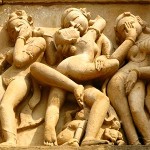
The Creators of Khajuraho claimed descent from the moon and the legend behind the founding of this great dynasty and the temples is a fascinating one. Hemwati, the lovely young daughter of a Brahmin priest, was seduced by the moon-god while bathing in a forest pool. The child born of this union was Chandravarman, founder of the Chandela dynasty. Brought up in the forests by his mother who sought refuge from a sensorious society, Chandravarman, when established as a ruler, had a dream-visitation from his mother. It is said that she implored him to build temples that would reveal human passions, and in doing so, bring about a realization of the emptiness of human desire. It is also possible that the Chandelas were followers of the Tantric cult, which believes that gratification of earthly desires is a step towards attaining the infinite liberation of nirvana.
Why they chose Khajuraho, even then a small village, as the site for their great complex is also open to of their faith and the many beliefs represented in the temples, the Chandelas conceived Khajuraho as a seat of religion and learning, to bring together many sects.
Khajuraho Archaeological Museum
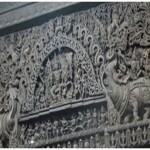 The politician of Bundelkhand, W E Jardine displayed objects from the temples in 1910. The display was held near the Western Group of Temples. This was originally called the Jardine Museum which in 1952 was rechristened to the Archeological Museum.
The politician of Bundelkhand, W E Jardine displayed objects from the temples in 1910. The display was held near the Western Group of Temples. This was originally called the Jardine Museum which in 1952 was rechristened to the Archeological Museum.
The objects displayed in the Khajuraho Archaeological Museum are sculptures and architectural remains of the 10th and 12th century temples. The objects reflect the influences of Hindu and Jain religions. The museum now houses more than 2000 objects. Among these some of the popular ones are the Nritta Gansha, Uma-Maheshwara, Andhakasuravadhamurti and Vaikuntha.
State Museum of Tribal & Folk Arts Brass Art, Khajuraho Tourism
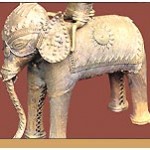
A fine collection of masterpieces of tribal and folk art and artifacts from all over Madhya Pradesh is on display at the Chandela Cultural Complex. The tradition of tribal and folk arts and crafts has evolved over centuries. It represents the best of Indian culture and tradition and its synthesis with foreign cultures that came through trade and invasions.
The State Museum has more than 500 representative items of terracotta, metal craft, woodcraft, tribal and folk paintings, tattoos, jewellery and masks.
Khajuraho Temples
The architectural style of the Khajuraho temples is very different from the temple prototype of that period. Each stands, instead of within the customary enclosure, on a high masonry platform. Combined with the upward direction of the structure, which is further accentuated by vertical projections, the total effect is one of grace and lightness, reminiscent of the Himalayan peaks. Each of the chief compartments has its own roof, grouped in such a way that the highest is in the centre, the lowest over the portico, a triumph of skill and imagination in recreating the rising peaks of a range.
Western Group of Khajuraho Temples
A compound wall encircles this group of temples. Within the enclosure are several large and small shrines.
Lakshmana Temple
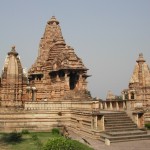 To the left of the entrance a path takes you up to the famous Lakshmana Temple, a grand edifice included in Western Group of Khajuraho tempes. Lakshmana Temple that stands on a high platform.
To the left of the entrance a path takes you up to the famous Lakshmana Temple, a grand edifice included in Western Group of Khajuraho tempes. Lakshmana Temple that stands on a high platform.
It is dedicated to Lord Vishnu – the preserver of the Hindu Trinity of Gods. If you are one of those who realise after coming all the way here that you won’t be able to walk so much, take heart – this temple alone will make your trip. Dating from 930-950 AD it is one of earliest temples going in Khajuraho. Take a Khajuraho trip to watch these magnificent temples. Considering its age, the Lakshmana Temple is remarkably well-preserved; in fact it is one of the best preserved temples of the whole lot.
According to the inscription on the Lakshmana Temple, it was built by a certain King Yasovarman to install a Vaikuntha-Vishnu image (which can still be seen here) gifted to him by his Pratihara overlord, Devapala.
The image was brought originally from Tibet (or Bhosa as it was known then), where the cult of worshipping Vishnu in his Vaikuntha (the multi-headed Vishnu) avatar was popular.
Lakshmana Temple Attractions
The outer wall of the Khajuraho Lakshmana Temple is exquisitely carved – indeed every inch of space bears the mark of the sculptor’s artistic flight of fantasyr. In front of it are two open pavilions or mandapas.
The one furthest to the south is the Varaha mandapa with a huge image of the standing Varaha (the boar incarnation of Vishnu), the preserver who rescued the earth from primeval floods (the ones that Noah sailed too, one presumes).
The entire body of the divine creature is carved in low relief along with the figures of more than 600 gods and goddesses of the Hindu pantheon. Besides the Varaha mandapa is a reconstructed Devi mandapa which once contained an image.
The platform that the temple stands on has a charming sculptural frieze of elephants and horsemen in procession. On the southern side are a few of the more explicitly erotic panels.
Climbing the stairs one reaches the broad platform of the temple meant for the ritual pradakshina or circumambulation. It is noteworthy in having a boundary railing and a subsidiary shrine in each corner.
The most delectable part of the temple scheme is the bands of sculptural decoration with exquisite figures of apsaras (celestial courtesans/nymphs), the guardians of the directions and other divine creatures. Erotic panels take a central position on the two balconies of the temple. On the western side are a few outstanding sculptures and the voluptuous, curvaceous forms of nude women with ornate jewellery.
The temple faces east and a steep flight of stairs leads up to the inner sanctum placed high above ground level. There is an entrance porch, a hall of pillars and interesting sculptural motifs on the sidewall. The inner ritual passage winds around the sanctum and is dressed with bands of sculpture in imitation of the temple’s external wall. The deity’s alcove is raised above floor level and contains within its dark interiors a large image of the Vaikuntha Vishnu, bearing three heads representing his various incarnations.
Kandariya Mahadev Temple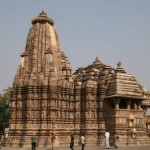
Travelling westwards from the Lakshmana Temple, making a trip along the garden path one comes to the largest and most handsome monument at Khajuraho, the Kandariya Mahadev Temple.
Built in around 1025–1050 AD, this sandstone structure (like all the other temples built entirely without the use of cement and mortar) stands almost 30m above ground level and is as long as it is tall. The temple is dedicated to Shiva (the destroyer of the Hindu Trinity of Gods), with a linga (phallic representation of Lord Shiva) at the centre of the garbha griha (the womb or innermost chamber of the temple).
The Eastern Group Khajuraho Temples Make a travel to the temples of Eastern Group are enclosed within a high compound wall, although some of them are also scattered around the old village of Khajuraho. Several of the Jain temples are still in worship and contain sculptures and carved doorways from older ruined Khajuraho temples of the area.
Parshvanatha Temple
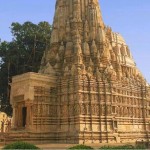 Within the protected zone is the Parshvanatha temple, a medium-sized building compared to the western group. It is the largest of the Jain temples and has an image of Parshvanatha, a Jain Tirthankara in the sanctum. The temple has been heavily renovated in this century.
Within the protected zone is the Parshvanatha temple, a medium-sized building compared to the western group. It is the largest of the Jain temples and has an image of Parshvanatha, a Jain Tirthankara in the sanctum. The temple has been heavily renovated in this century.
Some of the best known non-erotic sculptures of Khajuraho are found here, particularly the lovely sura-sundaris (celestial beauties) – one applying make-up and another removing a thorn from her feet on the southern façade and yet another tying on ankle-bells on the northern façade.
Adinatha Temple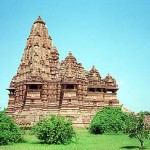
While the figures depicted in the Parshvanatha Temple are full and heavy, the sculpted figures of this temple are winsome and lithe. It has been partially restored over the centuries and has fine carvings on its three bands of sculptures.
Other Eastern Group Khajuraho Temple Attractions
The other noteworthy temples here are the Shanti Nath (rebuilt from older temples, only a century old) and Ghantal (interesting delicate columns, although in ruins).
Main Temple Attractions
The temple stairs lead to a platform decorated with rich sculpted figures of women in a variety of poses. There are women playing with a ball, some engaged in writing a letter, others applying make-up and absorbed in a multitude of other activities.
On the southern and northern sides, between the balconies are the large-scale erotic panels. In fact the mithuna (sensuously carved erotic figures) on the Kandariya Mahadev include some of the most energetic eroticism to be seen at Khajuraho.
Devi Jagdambi Temple
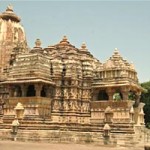 The Devi Jagdambi Khajuraho Temple stands on the same platform as the Kandariya Mahadev Temple. It is a smaller and much more precisely proportioned temple and is decorated with some of the finest sculptures at Khajuraho.
The Devi Jagdambi Khajuraho Temple stands on the same platform as the Kandariya Mahadev Temple. It is a smaller and much more precisely proportioned temple and is decorated with some of the finest sculptures at Khajuraho.
The garbha griha now houses a huge image of the goddess (Devi) of the Universe (Jagdambi), though it most probably started out as a Vishnu temple. It has the usual three bands of sculptures around it, but the third and most uppermost of these showcase some of the most erotic sculptures in Khajuraho.
Vishwanatha Temple
Moving back to the entrance gate, travel towards the northeastern corner of the Western Group Khajurho temple complex, there stands the magnificent form of the Vishvanatha Temple (about 1000 AD). It is similar in plan to the Kandariya Mahadev temple and is approached from the southern side.
On top of a wide platform is the small and dainty Nandi mandapa with an elegant pyramidal roof – you must check this one out if you are an art and architecture freak.
It has a large stone image of Nandi (Lord Shiva’s vehicle, a bull). He sits there with a sphinx-like expression that is hard to read – although it does seem, from certain angles, like he’s staring longingly at the temple before him, the house of his master.
The Vishwanatha Temple has some exquisite sculptural details and within the shrine is an exquisite marble Shivalinga (phallic representation of Shiva).
Chitragupta Temple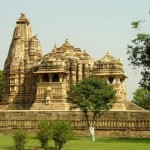
The Chitragupta Temple, dedicated to the Sun God – Surya,is a first and last here. Quite similar to the Devi Jagdambi Temple, it is not in very good repair, although attempts ,have been made to repair it.
Take a trip, about a mile away, near the Khajur Sagar are the smaller shrines of this group. The Brahma Temple is one of smallest in Khajuraho and has only a single room with a Shivalinga in the centre protected by a huge pyramidal roof. The Vaman and Javari Temples are set against a rural landscape amidst fields and pastures and are miniature versions in plan and design of the larger Western group of temples.
DuladeoTemple
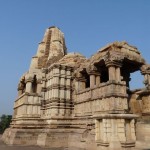 This Shiva temple is known for flaunting the striking images of the celestial maidens or apsaras and richly ornamented figures.
This Shiva temple is known for flaunting the striking images of the celestial maidens or apsaras and richly ornamented figures.
Chaturbhuja Temple It is the huge imposing intricately carved image of Lord Vishnu in the temple’s sanctum, which is the chief attraction of the temple.
Major attractions near Khajuraho
Ajaigarh and Kalinjar Forts in Khajuraho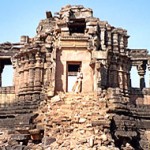
Kajuraho India Temple tour also includes a visit to Ajaigarh, about 80km from Khajuraho, features a large isolated hilltop fort. Like most forts, it was designed to protect the local population during attacks and sieges.
It was built by the Chandelas when their influence in the area was dwindling. The Kalinjar Fort, 25km north (bordering Uttar Pradesh) is much older. Built during the Gupta period, it was also mentioned by the much-travelled Ptolemy in the 2nd century AD.
Jatashankar Temple Shiv in Khajurahao
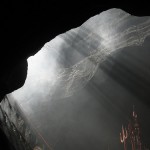 As is obvious from its name, this temple is dedicated to Lord Shiva (the third of the Hindu trinity of Creator-Preserver-Destroyer).
As is obvious from its name, this temple is dedicated to Lord Shiva (the third of the Hindu trinity of Creator-Preserver-Destroyer).
A hot water spring on the precincts is said to have medicinal properties that cure skin diseases. Unlike most Hindu temples, the very air of this temple seems sacred. Away from the din and noise of the city, the atmosphere is very relaxing. All the marriages in the area are solemnised in this temple with the blessings of Jatashankar.
A number of small bhojanalyas (roadside eating joints that serve only vegetarian food) line the stairs that lead to the kund (small body of water often used for bathing in Hindu temples) above.
You can try the delicious, hygienically cooked food at Aggarwal Bhojanalya, which stands right next to the last step, as you descend from the kund.
Bhim-Kund in Khajuraho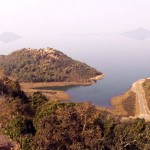
. Bhim, the strongest of the five brothers( in mahabharat), hit the ground with his gada (a kind of club with a round head, made of metal) and lo and behold, water surged out and the pool came into being.
The kund lies in an underground cave and is about 30m from the mouth. To the left of the entrance is a small Shivalinga (the phallic representation of Lord Shiva) But what’s truly astounding here is that the roof of the cave has a small opening just above the kund as this is the spot Bhim is said to have hit with his gada. The depth of this pool is believed to be measureless.
The pool is a lovely indigo blue which contrasts well with the red stone walls. There are some caves around it but no one has been adventurous enough to find out where they lead. There is something mysterious and exciting about this place, so much so that one almost tends to believe the pool’s epic origin.
Panna National Park of Kahajuraho
 About 32km from Khajuraho, the road to Satna (see below) passes through the Panna National Park along the River Ken. It contains large areas of virgin forest and a whole load of wildlife. There are tigers here but don’t count on seeing one! The numerous waterfalls in this area are popular picnic spots.
About 32km from Khajuraho, the road to Satna (see below) passes through the Panna National Park along the River Ken. It contains large areas of virgin forest and a whole load of wildlife. There are tigers here but don’t count on seeing one! The numerous waterfalls in this area are popular picnic spots.
How To Reach Khajuraho
By Air
Khajuraho airport, though small, connects it to different cities of India. Flights of major airlines like Jet Airways (to Varanasi, Delhi and Mumbai), Air Sahara (to Bhopal, Indore and Delhi), Indian Airlines (to Varanasi, Delhi and Agra) and Kingfisher Airlines (to Bhopal, Allahabad, Indore, Mumbai and Delhi) fly between Khajuraho and other important cities of India. There are also flights that help uou in reaching Khajuraho from Nepal.
By Rail
There is direct rail route to reach Khajuraho connected by Jhansi, Agra, Delhi. The nearest rail-heads are Harpalpur (94km) and Mahoba (63km). For people coming from North India, Jhansi (172km) is the most convenient railway station for traveling to Khajuraho. On the other hand, the Satna railhead located on the Mumbai- Allahabad railway route and at a distance of 117 km, is convenient for travelers from Mumbai, Kolkata and Varanasi.
By Road
Well maintained roads connect Khajuraho to cities, in and around Madhya Pradesh. Direct buses easily link Khajuraho to other places like Chhatarpur (42 km), Mahoba (63km), Harpalpur (94km), Satna (117 km), Jhansi (172 km), Gwalior (275 km), Agra (393 km) , Jabalpur (302 km), Bhopal (400 km), Indore (600 km). Buses of the MP tourism runs between Khajuraho and all these cities. Private tour operators also provide AC/ Non AC, Deluxe/ Non-Deluxe bus services to tourists traveling to Khajuraho.
Facts
Population 19,282(2001)
Area 16.93 sq kms
Longitude 79° 56′ 0″ E
Latitude 24° 51′ 0″ N
Language Hindi,English
State Madhya Pradesh
Best time to visit October to March
Submit your review | |
